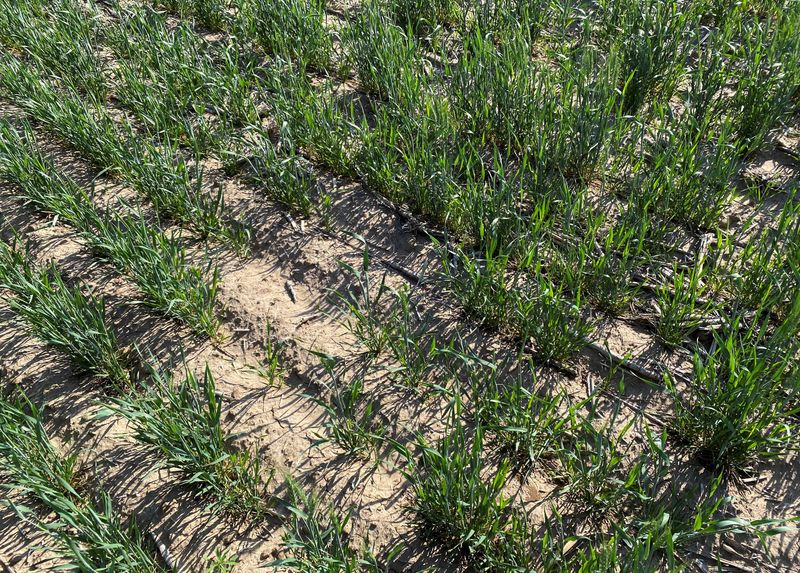By Julie Ingwersen
CHICAGO (Reuters) - U.S. farmers are about halfway done planting winter wheat for harvest in 2024, but acreage is expected to remain stable or decrease from last year because of lower prices and farmers' disenchantment with the crop after three years of drought.
A smaller acreage base sets the stage for reduced U.S. wheat production, tightening global supplies and leaving the world more vulnerable to shortages if the flow of wheat from top global exporter Russia is disrupted by poor crop weather or war in Ukraine.
U.S. wheat exports are already projected to hit a 52-year low in the 2023/24 marketing year, reflecting strong competition from Russia and other suppliers.
A government forecast of U.S. winter wheat acreage, which typically accounts for about two-thirds of overall U.S. wheat production, will not be available until January. That will be well after the crop is planted. But analysts and farmers mostly told Reuters they expect plantings to be similar to or smaller than a year ago.
S&P Global projects plantings for 2024 at 36 million acres, down roughly 2% from a year ago, based on a monthly survey of farmers and agribusinesses.
"I think the trend would be sideways to lower for acres," said Dan O’Brien, an agricultural economist at Kansas State University. "The psychology of recent challenging experiences, both in the market and in harvesting last year's crop, are working against wheat acres," O'Brien said.
U.S. plantings of winter wheat, used for bread and cookies, totaled 36.7 million acres for the 2023 harvest, a 21% expansion from a 111-year low in 2020. Over the last few years farmers have gradually expanded plantings, fueled by pandemic supply chain disruptions and a price spike after Russia invaded major grains producer Ukraine in 2022.
Last year's plantings figure was still well below levels seen a decade ago. While the United States is still among the top five exporters, it has slipped in the global rankings. Competitive prices for corn and soybeans have also squeezed out wheat in the Plains and Midwest. Wheat futures on the Chicago Board of Trade are near three-year lows, and K.C. hard wheat futures are hovering at two-year lows.
Crop insurance policies that guarantee minimum prices for the 2024 wheat crop were set in mid-September at $7.34 a bushel for Kansas wheat, down $1.45 a bushel from last year. This soured some growers who relied on insurance money in the past after abandoning their crops due to drought.
Vance Ehmke, who farms in west-central Kansas, said he will plant less wheat this year in favor of other crops including triticale, used for cattle feed. Ehmke predicted that Kansas wheat acreage would stay about the same, but that wheat could lose acres in wetter areas of the state that can support more profitable crops like soybeans.
Farmers hope the El Nino climate phenomenon, which occurs when surface waters in the equatorial Pacific Ocean are warmer than normal, will end years of winter droughts. Climatologists are divided on how much rain the phenomenon will bring to the southern Plains.

Wheat seed, meanwhile, is expensive and in tight supply. Three years of drought reduced farmers' ability to reuse their own seed, so many had to buy certified seed, said Eric Woofter, a farmer and chief executive of Star Seed in Osborne, Kansas.
"It's in short supply, and oh my God, ever so expensive," said Chris Tanner, who farms in Norton County, in northwest Kansas. "I don't feel like the profitability is going to be there," Tanner said of winter wheat.